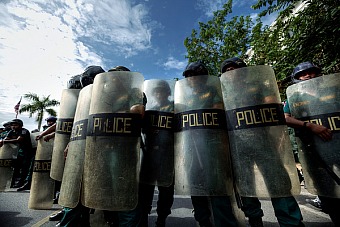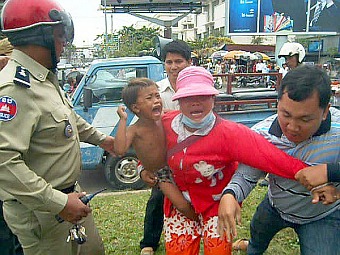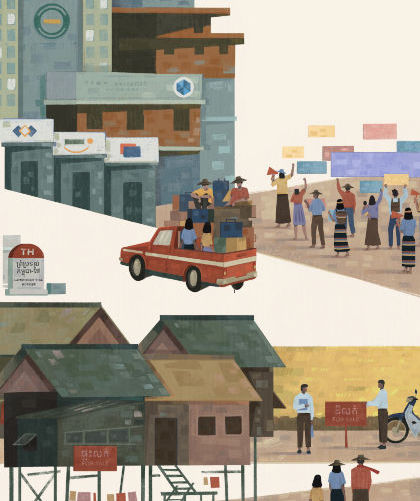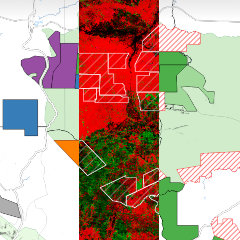2012 in Review: Land Grabbing, the Roots of Strife
Published on 12 February 2013The human rights situation in Cambodia began 2012 teetering on the edge of a precipice, and by the end of the year had fallen off the cliff.
The sheer volume of shocking turns makes it difficult to choose where to begin a summary of 2012: Independent radio station owner Mam Sonando was sentenced to 20 years in prison on politically-motivated charges. The country’s most prominent environmental activist was shot dead in the forest while investigating illegal logging. A journalist working on logging issues was murdered in Ratanakiri province. A town governor opened fire on protesting garment workers and has yet to spend a day in prison. And 17 leaders from Phnom Penh communities facing eviction spent time in prison.
This has been the most violent year ever documented... in terms of the authorities using lethal force against activists.
A one-month period alone in April and May saw 15 human rights defenders jailed, an activist monk detained and threatened, and three people shot dead by state forces. Meanwhile, a three-day period in December saw an NGO staff member summoned to court for questioning on charges related to his work, two land activists sentenced to prison time, and the unfathomable re-conviction of two men – widely acknowledged as scapegoats and already freed once by the Supreme Court – for allegedly murdering unionist Chea Vichea in 2004.
Between November 2011 and December 2012, there were at least nine incidents in which authorities opened fire on civilians, making 2012 the most violent year ever documented in terms of authorities’ use of lethal force against activists.
As part of the lead up to the release of our report “Human Rights 2012: the Year in Review,” on February 18, LICADHO is publishing a four-part web series reviewing the key human rights events of 2012. Daily installments will be published throughout the week, culminating with the publication of our report on February 18.
Land Grabbing: The roots of Strife
The most important source of strife continued to be the unlawful seizure of land by state authorities, usually on behalf of well-connected business interests. A joint LICADHO study published in the Cambodia Daily in March found that more than 22 percent of Cambodia’s total land mass has been granted to private firms in the form of concessions. In Phnom Penh and the 12 provinces in which LICADHO works, land grabbing has affected an estimated 400,000 Cambodians since 2003, helping to create a sizable under class of landless villagers with no means for self-sustenance.
Just days into the new year, on January 3, authorities and hired workers clashed with residents of Phnom Penh’s Borei Keila neighborhood as they demolished the homes of some 300 families. The houses were crushed before the residents had the chance to salvage their belongings. The process was overseen by over 100 mixed police forces, who fired tear gas and live ammunition at the residents. Eight community representatives, including a minor, were arrested and detained.
The company developing their land, Phanimex, had acquired the property as part of a novel “land sharing” deal, in which the firm signed a contract with the government agreeing to build apartment buildings onsite for the displaced residents. The firm only completed eight of the 10 buildings.
A week later, 30 Borei Keila residents – 24 women and six children – were arrested in front of Phnom Penh Municipality while calling for Phanimex to abide by its side of the agreement. The residents were detained without charges at the infamous government-run Prey Speu Social Affairs Center, a center that has repeatedly been used as a warehouse for “undesirables” that the government cannot criminally charge. All of the detainees eventually escaped or were released.
Meanwhile, residents in a Poipet village were the latest victims in a string of land disputes linked to Cambodia’s railway rehabilitation project. On April 5, 22 families living along the railway tracks received an eviction notice from the local authorities. The order purported to give them 10 days to remove their structures from the vicinity of the tracks, but they received the notice only one day before the deadline. As of the date of this report, the residents remain.
Villagers in Preah Sihanouk province were also victims of a forced eviction in 2012. On May 26, 60 hectares of plantations and homes belonging to 15 families in Sangkat 1 Commune were destroyed by armed forces – reinforced by prisoners - led by Preah Sihanouk provincial prosecutor Bou Bunhang. The land was earmarked for the construction of a new prison. The evicted villagers were not provided compensation and at least one villager was seriously injured during the operation.
The government issued a moratorium on new land concessions in May, but by June, LICADHO documented the granting of at least 12 concessions, totaling more than 80,000 hectares. The government then clarified that the moratorium did not apply to concessions that were already “agreed in principle” – though there is no public list of such concessions. In other words, the moratorium contained a loophole so large that it swallowed the ban itself.
In response to increasing outcry over land conflict, the Prime Minister announced a new land titling scheme in June, involving the use of 1,600 student volunteers dressed in military uniforms. Over the second half of 2012, the volunteers crisscrossed the country to measure land and issue titles. While a push to expedite the issuance of land titles is laudable in theory, the program completely bypassed established state institutions set up explicitly to perform such duties. It is also being implemented in a secretive manner, with no provisions for independent monitoring. There have been numerous credible reports of affected land owners being intimidated into accepting terms dictated by the volunteer students. As of the end of 2012, the land titling program continues to be implemented.
In September, LICADHO published an interactive timeline map which visualizes the granting of land concessions in Cambodia from 1993 to the present. The map vividly shows how the number of concessions has rapidly accelerated in recent years, and is periodically updated as new concession data becomes available.
MP3 format: Listen to audio version in Khmer
- Topics
- Land Rights









